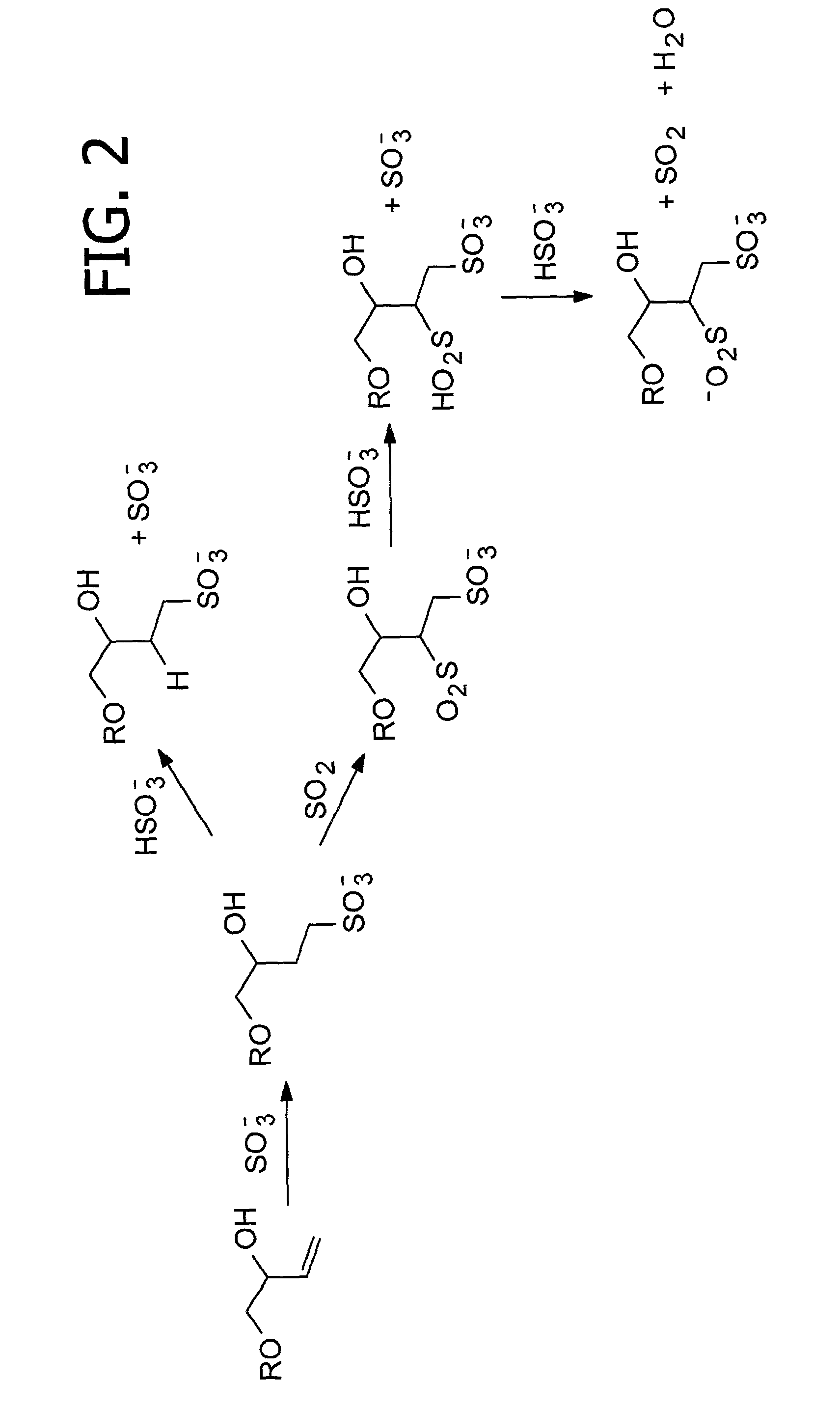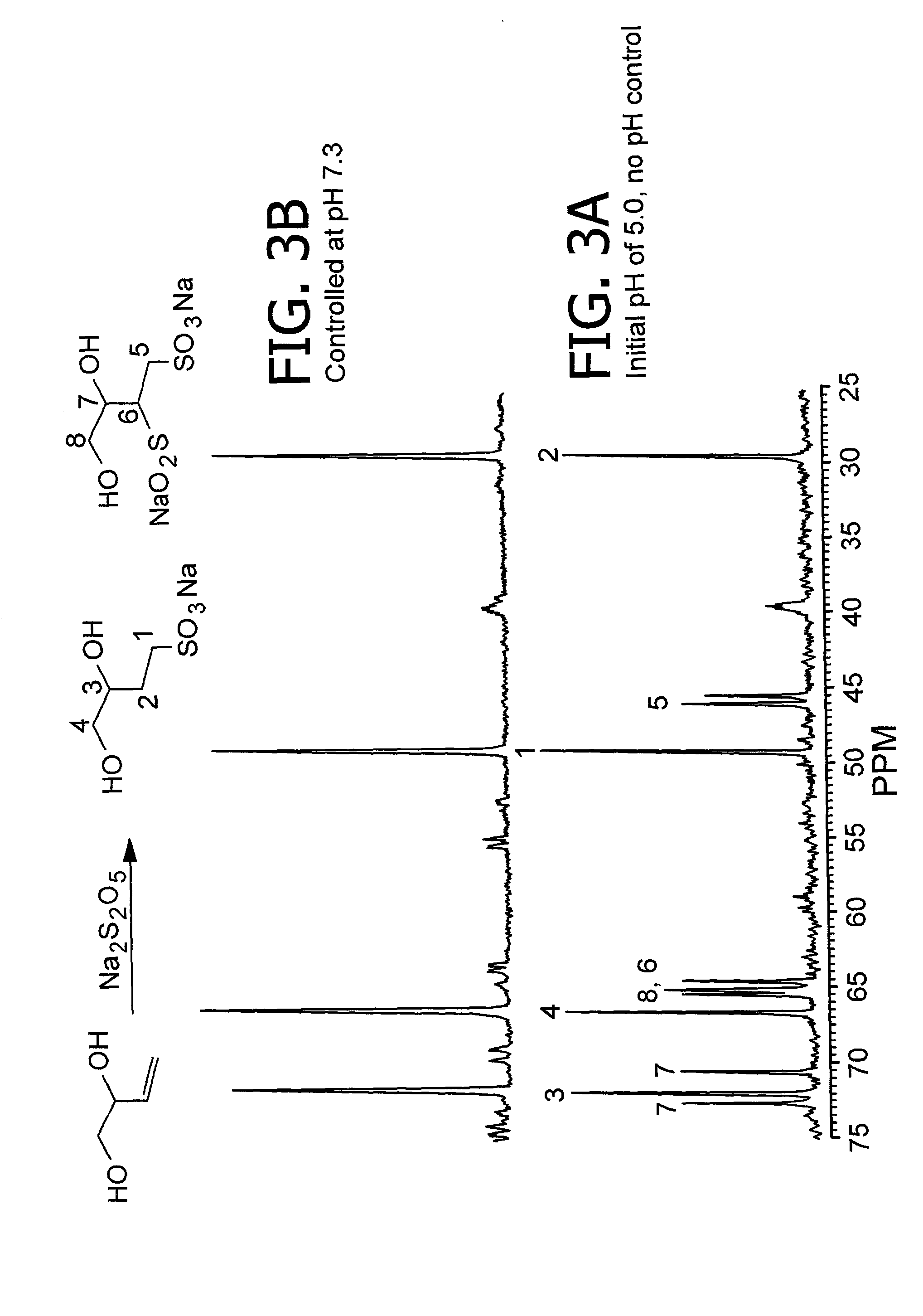Cyclodextrin sulfonates, guest inclusion complexes methods of making the same and related materials
a technology of cyclodextrin sulfonates and complexes, applied in the field of cyclodextrin sulfonates, guest inclusion complexes methods of making the same and related materials, can solve the problems of general limited use of unmodified cd in clinical settings, observed necrotic damage, and difficult preparation of the product, and achieve the effect of low cos
- Summary
- Abstract
- Description
- Claims
- Application Information
AI Technical Summary
Problems solved by technology
Method used
Image
Examples
example 1
[0074] Sulfonation of 3,4-dihydroxy-1-butene without pH Control.
[0075] In a typical procedure, a 10 mL one-neck round bottom flask was charged with 0.53 g (6 mmol) of 3,4-dihydroxy-1-butene dissolved in 1 mL of deionized water. To this solution was added 1.25 g of Na.sub.2S.sub.2O.sub.5 dissolved in 2 mL of deionized water. The initial pH of the reaction mixture was 5.0 and no attempt was made to control the pH. The flask was then placed in a preheated oil bath at 100.degree. C. The reaction was stirred at 100.degree. C. for 2 h at which time thin layer chromatography (tlc) indicated complete disappearance of the 3,4-dihydroxy-1-butene (Rf=0.52, EtOAc). The reaction mixture was concentrated to dryness to yield 1.51 g of a white powder. The sample was then analyzed by NMR spectroscopy. The results from this experiment and other experiments involving the same procedure but conducted at different pH are summarized in Table 2.
2TABLE 2 Influence of pH on Sulfonation of 3,4-dihydroxy-1-bu...
example 2
[0077] Sulfonation of 3,4-dihydroxy-1-butene with pH Control.
[0078] A 50 mL one-neck round bottom flask was charged with 1.0 g (11.4 mmol) of 3,4-dihydroxy-1-butene dissolved in 2 mL of deionized water. A second solution was prepared by dissolving 2.38 g of Na.sub.2S.sub.2O.sub.5 in 5 mL of deionized water. The pH of the Na.sub.2S.sub.2O.sub.5 solution was adjusted to 7.3 with 4 M NaOH and 1 M H.sub.2SO.sub.4. The flask containing the 3,4-dihydroxy-1-butene solution was then placed in a preheated oil bath at 65.degree. C. To the 3,4-dihydroxy-1-butene solution was added the Na.sub.2S.sub.2O.sub.5 solution dropwise (addition time=8 min). The reaction was stirred at 65.degree. C. During the course of the reaction, the pH was observed to drift to a higher pH. The pH of the reaction solution was readjusted to 7.1-7.3 by the addition of 1 M H.sub.2SO.sub.4. After 4 h, thin layer chromatography indicated disappearance of the 3,4-dihydroxy-1-butene. The reaction was concentrated to dryness...
example 3
[0080] Preparation of Sodium 3,4-dihydroxybutane-1-sulfonate.
[0081] To a 3000-mL, four-neck, Morton flask equipped with a mechanical stirrer, pH probe, condenser, addition funnel, thermocouple, gas dip tube and heating mantle was added 190.2 g (1.001 mole) of sodium metabisulfite and 640 mL of water. The pH 3.9 solution was adjusted to 7.1 by the addition of 136 g (1.70 mole) of 50% aqueous sodium hydroxide. Air was introduced into the headspace of the flask. The mixture was heated to 55.degree. C. and stirred rapidly to introduce air into the solution. Two moles (176.2 g) of 3,4-dihydroxy-1-butene were added over three hours at 55-56.degree. C. while controlling the pH of the solution at 7.3 to 7.6 by the periodic addition of sulfur dioxide via the gas dip tube. The reaction was continued until the pH stopped drifting (five hours total). NMR showed complete sulfonation of the olefin. The product solution was concentrated to a give a milky white mixture by rotary evaporation at 60.d...
PUM
| Property | Measurement | Unit |
|---|---|---|
| pH | aaaaa | aaaaa |
| temperature | aaaaa | aaaaa |
| temperature | aaaaa | aaaaa |
Abstract
Description
Claims
Application Information
 Login to View More
Login to View More - R&D
- Intellectual Property
- Life Sciences
- Materials
- Tech Scout
- Unparalleled Data Quality
- Higher Quality Content
- 60% Fewer Hallucinations
Browse by: Latest US Patents, China's latest patents, Technical Efficacy Thesaurus, Application Domain, Technology Topic, Popular Technical Reports.
© 2025 PatSnap. All rights reserved.Legal|Privacy policy|Modern Slavery Act Transparency Statement|Sitemap|About US| Contact US: help@patsnap.com



